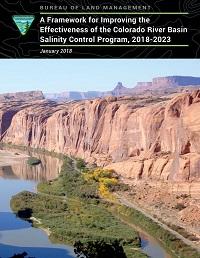A Framework for Improving the Effectiveness of the Colorado River Basin Salinity Control Program 2018-2023

The Colorado River is an important source of water for about 40 million people in portions of seven western states (Arizona, California, Colorado, Nevada, New Mexico, Utah, and Wyoming). This water provides irrigation to almost 5.5 million acres of agricultural crops, sustains habitat for numerous aquatic and riparian species, and provides abundant recreational opportunities to residents and visitors. A variety of natural processes and human uses cause dissolved salt concentrations in the river to increase from about 50 milligrams per liter (mg/L) near its headwaters in the Rocky Mountains to almost 850 mg/L near the border with Mexico. Excessive salt concentrations can result in substantial environmental and economic damages. Associated costs include loss of ability to irrigate some types of crops, increased water treatment costs for domestic users, increased water treatment costs for utilities to comply with Clean Water Act discharge permit requirements, and increased costs for industry to maintain boilers and treat water to meet manufacturing needs. Recent analyses by the Bureau of Reclamation indicate quantifiable damages from excessive salt concentrations are about $382 million per year.
Congress passed the Colorado River Basin Salinity Control Act of 1974 (the Act) to address concerns by water users about increasing salt concentration in the Colorado River, help resolve a longstanding dispute with Mexico about the quality of water delivered under an international treaty, and provide a framework to assist states with administering Clean Water Act amendments passed in 1972. The Act relies upon a unique partnership of federal and state agencies that continues to work cooperatively with numerous regional water management agencies, hundreds of local companies, and thousands of individual water users to reduce and maintain salt concentrations in the river at an acceptable level as determined by numerical water quality standards. As an integral component of the partnership, the Bureau of Land Management (BLM) is responsible for about 53 million acres within the Colorado River Basin and is required to reduce salt transport from these lands under subsequent amendments to the Act.
This framework identifies priority activities that the BLM will focus on from 2018 to 2023 to improve management effectiveness of the Colorado River Basin Salinity Control Program. Specific objectives include: (1) Continue implementing activities to reduce salt and sediment transport; (2) Develop additional capabilities to quantify and report effectiveness of management activities; (3) Strengthen partnerships and increase collaboration with federal partners, states, and other stakeholders; (4) Improve availability and access to monitoring data; and (5) Enhance and maintain technical expertise and project management capabilities.
